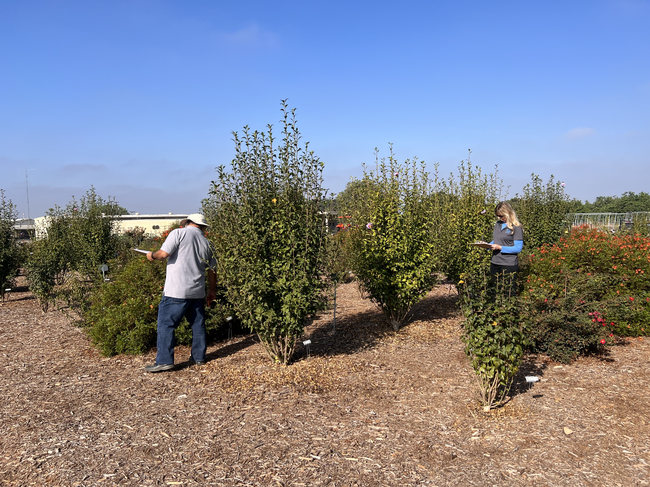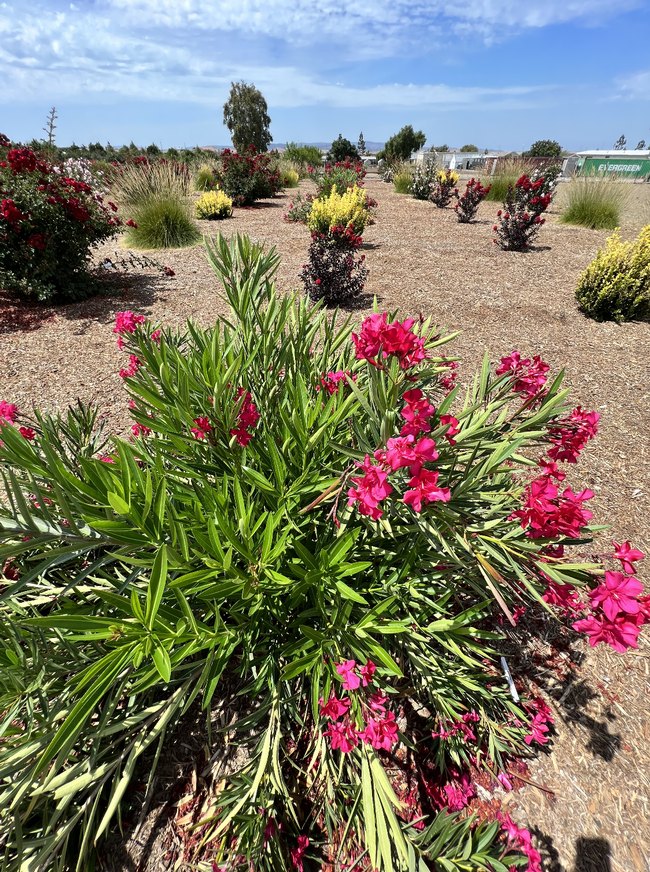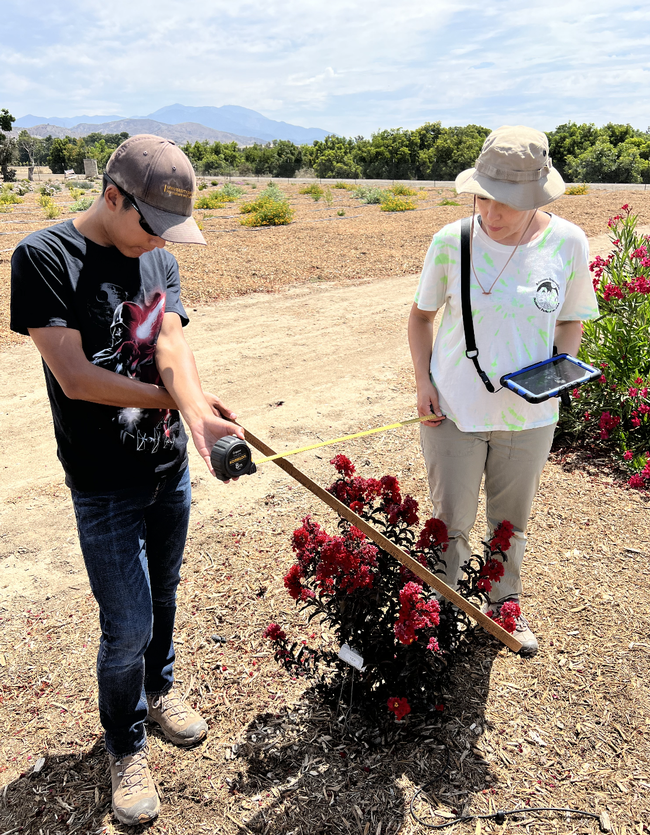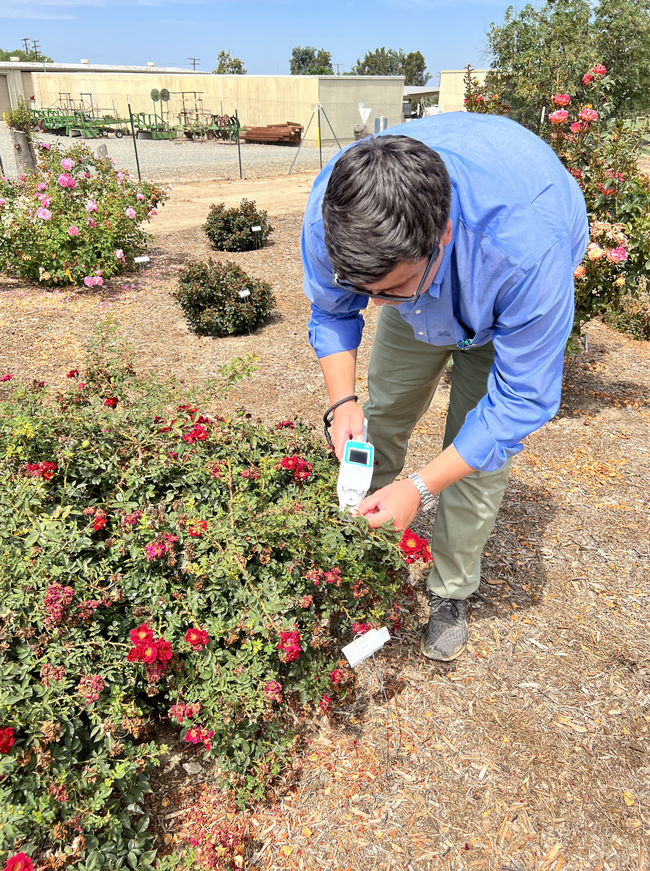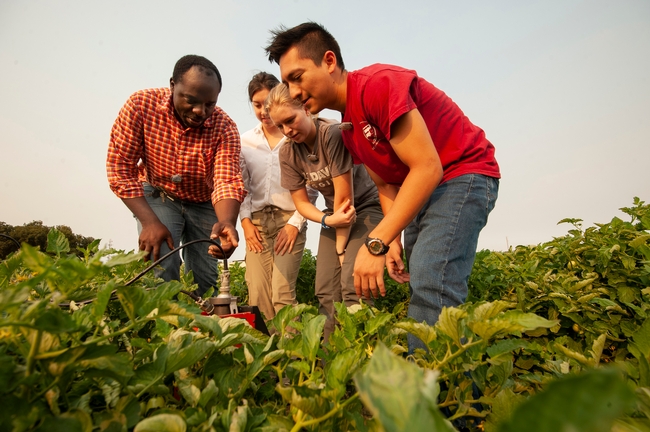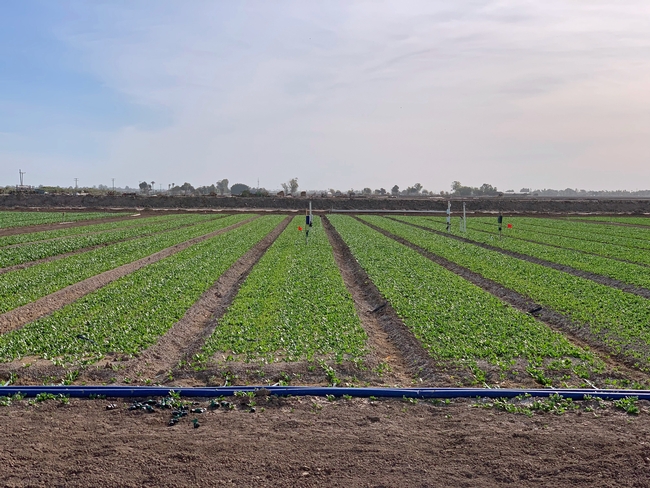Posts Tagged: irrigation
Your water-efficient landscape doesn’t have to be barren
UC climate-ready landscape trials identify low-water yet attractive plants
Good news: roses can be a part of your water-efficient landscape. Lorence Oki, UC Cooperative Extension environmental horticulture specialist in the UC Davis Department of Plant Sciences, identified rose cultivars that remain aesthetically pleasing with little water.
Oki is the principal investigator of the Climate-Ready Landscape Plants project, which may be the largest irrigation trial in the western U.S., and the UC Plant Landscape Irrigation Trials (UCLPIT), the California component of that project. These projects evaluate landscape plants under varying irrigation levels to determine their optimal performance in regions requiring supplemental summer water.
“There are some assumptions that pretty plants use a lot of water, like roses,” Oki said. “Everyone thinks they need a lot of water, but we've found some that don't, and they still look great. A water-efficient landscape doesn't need to look like a Central Valley oak-grassland in the summer. It can look really attractive.”
In 2021, Oki's team at UC Davis identified Lomandra confertifolia ssp. pallida "Pom Pom" Shorty and Rosa "Sprogreatpink" Brick House® Pink as two of the best low-water plants in the trial.
“The useful tip or information that is shared at the end of each trial is the selection and designation of plants as Blue Ribbon winners. These are the plants that looked good with an overall rating of 4 or higher throughout and were on the low (20%) water treatment,” said Natalie Levy, associate specialist for water resources, who manages the project at the UC ANR South Coast Research and Extension Center.
How plants earn a blue ribbon
Each trial year, the selection of new plants is based on research recommendations and donated submissions from the nursery industry. The landscape plants are trialed in full sun or 50% shade cover.
Irrigation treatments are based on the rate of evaporation and plant transpiration (evapotranspiration) measured through a local California Irrigation Management Information System (CIMIS) weather station that provides a reference evapotranspiration (ETo) rate.
Three levels of irrigation are provided to the plants equal to 20%, 50%, and 80% of ETo. The volume of water applied is the same at each irrigation based on soil characteristics, but the interval between applications varies with weather and the treatment. Using this method, irrigations for the 20% treatment are less frequent than the 80% treatment.
“The 20% treatment during the 2022 trial was irrigated an average of once per month while the 80% treatment was irrigated weekly,” explained Levy.
During the deficit irrigation trial, monthly height and width measurements are taken to determine the plant growth index. Monthly qualitative aesthetic ratings on a scale of 1 to 5 are determined for foliage appearance, flowering abundance, pest tolerance, disease resistance, vigor and overall appearance.
A second round of flowering abundance and overall appearance measurements are also taken to capture more of the blooming period. For example, UCLPIT identified in the 2020 trial at South Coast REC that the "Apricot Drift" rose had a mean overall appearance score of 3.5 out of 5, deeming it “acceptable to very nice” and a low water use plant within the Water Use Classification of Landscape Species or WUCOLS guide.
Project expands options for landscape planting
“(WUCOLS) only has 3,500 plants in it. There are guesses that there are close to 10,000 cultivars in urban landscapes in California, if not more,” said Oki. “WUCOLS also didn't have numerical ratings. Instead, you'll see verbal ratings like ‘low water use' or ‘high water use.'”
The UCLPIT project has not only developed numerical recommendations for irrigation, but it has also added new landscape plants that are compliant with California's Model Water Efficient Landscape Ordinance. In fact, UCLPIT's data is one of the few sources that can be used to supplement WUCOLS.
Geographic diversity of trial sites adds to knowledge base
In addition to UC Davis and South Coast REC in Irvine, the trials have expanded beyond California as the Climate-Ready Landscape Plants project and is in progress at Oregon State University, University of Washington, University of Arizona and Utah State University thanks to a USDA/CDFA grant awarded in 2020.
Lloyd Nackley, associate professor of nursery production and greenhouse management at Oregon State University, is the principal investigator of the trial in the Portland metro area, which is entering its third year.
“People know that there are drought tolerant plants, but there are many. We're trying to highlight lesser known or newer varieties. And even though the trial is three years, most gardeners would hope that their garden lasts longer than that,” said Nackley.
One of the observations that Nackley recalls is of the Hibiscus Purple Pillar plant. Unlike the trial at South Coast, the Purple Pillar did not perform well in Oregon in the spring.
“It wasn't until August that we saw the plant bloom and begin to look like what we saw from South Coast in April,” Nackley said.
Ursula Schuch, horticulture professor and principal investigator of the trial taking place at the University of Arizona, was also surprised at the range of performance among different plant types and the effects of irrigation, heat and temperature.
“This research will reassure green industry professionals that they can stretch their water budget to successfully cultivate more plants, watering them according to their needs instead of irrigating every plant according to the highest water-using plants,” said Schuch.
Although research is only conducted in the West, the hope is that there will be trials in other regions of U.S.
Doing so would yield comprehensive information about the plants and their performance in different climates. As extreme weather events persist in the U.S., disease pressure and risks do too. Trials throughout the country would provide location-specific data regarding disease susceptibility.
To learn more about the UCLPIT research project, visit https://ucanr.edu/sites/UCLPIT/
UC Davis to lead groundwater and irrigated agriculture sustainability study
Effort Will Develop Ways to Minimize Risk from Climate Extremes for Southwest Growers
Researchers from the University of California, Davis, have been awarded a $10 million grant by the U.S. Department of Agriculture's National Institute of Food and Agriculture to find ways to sustain irrigated agriculture while improving groundwater quantity and quality in the Southwest under a changing climate.
Isaya Kisekka, associate professor of agrohydrology and irrigation at UC Davis, is leading a team of more than two dozen climate, plant and soil scientists; hydrologists; engineers; economists, educators and extension specialists from UC Davis and other institutions in California, Arizona and New Mexico. They will develop climate change adaptation management strategies that ensure sustainability of groundwater and irrigated agriculture.
Kisekka says the project team in California will work with Groundwater Sustainability Agencies to develop tools and data to enhance water management at both the farm and groundwater basin scales to improve crop production and achieve sustainability goals under the state's Sustainable Groundwater Management Act, which provides a statewide framework to help protect groundwater resources over the long-term. The research team will also work with grower coalitions to achieve the groundwater quality goals of the Central Valley Salt and Nitrate Management Plan.
“For farmers, the biggest challenge threatening their business is water,” Kisekka said. “Our project is going to develop climate-smart adaptation management practices to help growers achieve their production goals while addressing the co-benefits for the environment and human health. We are going to develop cutting edge tools to manage groundwater quantity and quality as well as study how policies impact behaviors such as water use in agriculture.”
The practices, models and tools developed will be used by growers or their advisors, policymakers, irrigation districts, coalitions and groundwater sustainability agencies to address climate change extremes such as drought or floods.
Growing dependence on groundwater
Growers have increasingly depended on groundwater during multi-year droughts and heat stress. Part of the five-year project includes looking into aquifer systems in California's Central Valley, central Arizona and the lower Rio Grande basin in New Mexico. These regions have all experienced unprecedented overdraft, which happens when more water is pumped from a groundwater basin than is replaced from sources, including rainfall.
“For a long time, a lot of farmers would use groundwater as an insurance policy whenever there was a drought,” Kisekka said. “The negative consequences of that became obvious: groundwater levels declined, we had subsidence which causes land to sink, we had deterioration in water quality and so on. What are growers going to do when we have another drought like we are now? We have to think more broadly.”
Kisekka says they will also come up with management practices to improve soil health, develop alternative water supplies and reduce water demand so the region can continue to produce various agriculture commodities, such as vegetables, grapes and almonds.
“We grow crops in California that we cannot shift to another part of the country because they won't grow well there,” Kisekka said. “We can't grow almonds in the Southeast where they have a lot of water because they require a certain climate. We want to ensure food and nutritional security of the United States by sustaining irrigated agriculture in the Southwest.”
Project researchers will also establish innovative education and extension programs to teach students of all backgrounds and ages, as well as the public, about the importance of water in agriculture.
“Part of this is to develop educational curriculums from elementary to high school to college, where instructors can pull our modules on water management or sustainable agricultural systems and teach that in their classes,” Kisekka said.
While the depletion of groundwater supplies, among other factors, puts major pressure on agricultural operations in the southwestern region, Kisekka hopes the management practices and tools that will be developed during this project will help improve production and resource sustainability and help make California and the country more resilient to climate change. UC Davis will establish the Agricultural Water Center of Excellence as part of the grant. This unique Center of Excellence will also have capacity to support agricultural water research, education and extension activities at collaborating institutions with potential impact at local, state, national and international levels.
“We hope at the end of the day we can still grow food in California and the Southwest in general without drying out our groundwater aquifers,” he said. “We have to learn to adapt to climate change. We may not be able to stop it in the short term, but we should be able to adapt.”
Researchers from University of California, Berkeley, UC Agriculture and Natural Resources, Stanford University, CSU Fresno, University of Arizona, New Mexico State University, USDA Agricultural Research Service (Sustainable Agricultural Water Systems Research: Davis, CA and Water Management and Conservation Research: Maricopa, AZ) and USDA Climate Hub are also participating in the project.
Drip irrigation continues to yield benefits
Considered among the most important agricultural innovations in the world, drip irrigation has been researched for decades. UC Cooperative Extension weed management advisor Aliasghar Montazar has taken a close look at its application in organic spinach cultivation, reported Matthew Grassi in Growing Produce.
Not only does drip irrigation use less water than irrigation with sprinklers, the slow emission of water near plant roots also diminishes the crops' susceptibility to disease. Growers believe that ongoing issues with downy mildew is at least partially caused by moisture that sprinklers leave in the plant canopy.
“Being certified organic, there is really nothing they can use as fungicide; so it is a big problem,” Montazar said. “So, we said ‘Let's try drip (irrigation) in spinach.'”
Early results are promising. Montazar has analyzed enough field data from the plots to directly correlate a four- to five-times reduction in downy mildew disease in plots grown with drip irrigation compared to sprinkler-irrigated plots.
“The other thing to note is there is a nice savings on energy as well,” Montazar said. “Another grower reported he saved $200 an acre on energy savings from getting off the sprinklers. Because with drip, there is less pressure needed, so it consumes less energy (to pump water).”
2017 Kearney Alfalfa and Forage Field Day Presentations Now Available On-Line
As the alfalfa hay harvest season wraps up and we get in gear to attend the November 2017 Western Alfalfa and Forage Symposium in Reno, NV, we're...
Managing alfalfa hay during heat waves
Dog gone it's hot! This is expected in our Central Valley at this time of year, but when heat waves hit, it's important to be prepared with good...


